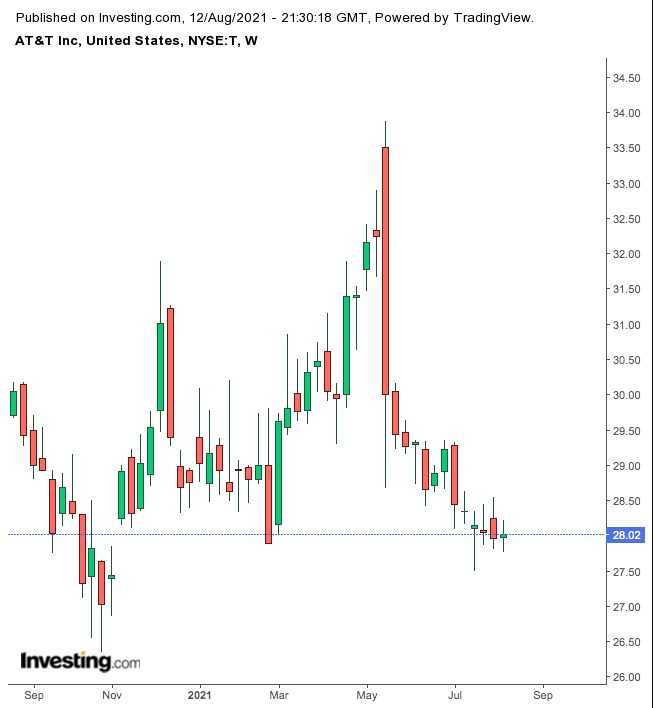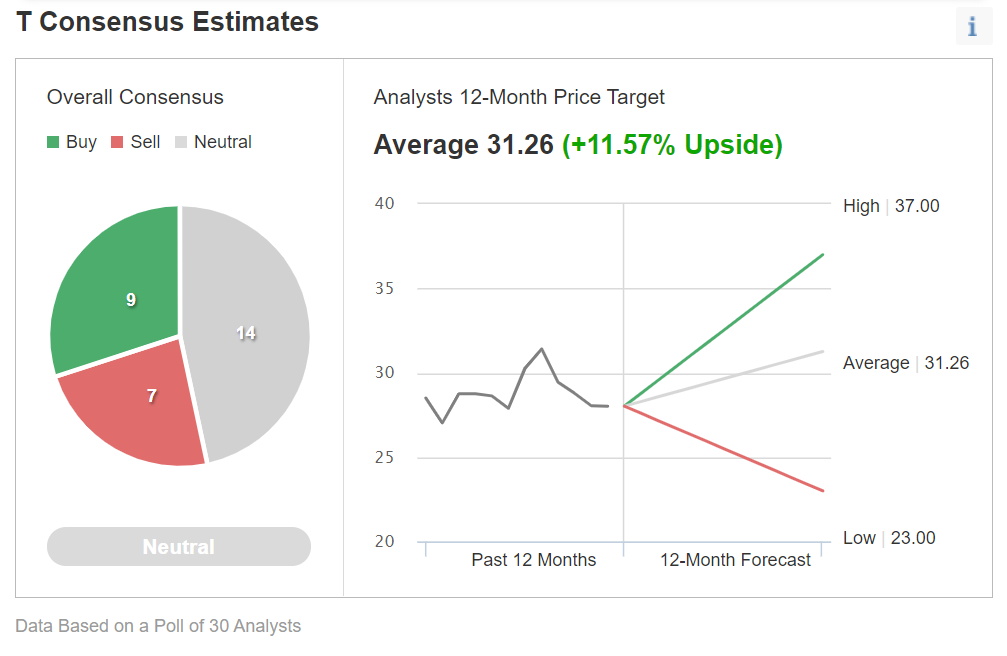For those investors chasing high yields, AT&T (NYSE:T) is a stock that immediately garners attention. America’s largest telecom operator is currently offering what looks like a very attractive risk-reward proposition for income investors.
The stock now yields more than five times what the companies listed on the S&P 500 are offering, on average. With an annual yield of 7.4%, investors can earn one of the best returns available from a blue-chip stock that has a long track record of paying dividends.
But that return doesn’t come without risk. Shares of the Dallas-based company have been underperforming the benchmark S&P 500 for many years. They have fallen 35% during the past five years—a period in which the S&P 500 more than doubled. Shares were trading at $28.02 at yesterday's close.

AT&T’s dismal performance is a reflection of the company’s debt-loaded acquisition strategy, which has so far failed to unlock value for its shareholders. For example, the company has lost nearly 10 million TV customers since acquiring the DirecTV satellite service in 2015.
To deal with these challenges, AT&T is going through an aggressive turnaround plan that includes shifting its loss-generating TV operations to a joint venture with TPG Capital and spinning off its media brands—including HBO, CNN, TNT, TBS and the Warner Bros. studio—into a new publicly-traded company with Discovery (NASDAQ:DISCA) next year.
“We want to hit a strong exit velocity with both of these businesses, at which point the combination with the right partner only expands to respective opportunities for success,” Chief Executive John Stankey said during a call with analysts last month.
Dividend In Danger
But that restructuring has created doubts in the minds of investors regarding the stability of the company’s $0.52-a-share quarterly dividend.

Chart: Investing.com
According to a poll by Investing.com, of 30 analysts covering the stock, 14 have a neutral rating on the equity, with nine recommending a buy and seven a sell.
Argus Research in a recent note downgraded AT&T to hold from buy, saying the company’s transformation could lead to a dividend cut in the near term.
The note said:
“While management has assured investors that AT&T will maintain a dividend in the ’95th percentile’ of companies, the math just doesn’t work after taking the DirecTV and WarnerMedia spinoffs into account. As such, we will take a wait-and-see approach as the company restructures through large divestitures while also implementing its costly 5G network buildout.”
Despite this pessimism, AT&T’s move to create a new streaming giant, combining AT&T’s HBO, Warner Bros. and TNT with a roster of Discovery channels, including the Food Network, and reality-TV shows, means the company will have a better chance to succeed in a market where deep-pocketed tech companies like Apple (NASDAQ:AAPL) and Amazon (NASDAQ:AMZN) are spending tens of billions of dollars a year on media content.
AT&T last month reported about 67.5 million worldwide subscribers to its premium channel and streaming service, and now says it will have 70 million to 73 million by the end of 2021.
Bottom Line
AT&T will likely become a much leaner and more focused company by next year if it’s able to successfully complete its current restructuring. The separation of the media assets will allow it to invest aggressively in its new streaming unit, while positioning the core telecom operations to expand when the introduction of the 5G technology is creating new opportunities.
That said, the new AT&T is unlikely to satisfy those investors whose aim is to earn steadily growing income. AT&T, in our view, is now a turnaround bet rather than a company that pays stable dividends.
